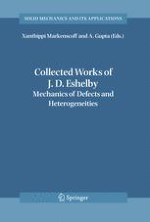2006 | Buch
Über dieses Buch
J.D. Eshelby's work has shaped the fields of defect mechanics and micromechanics of inhomogeneous solids in the last fifty years and provides the basis for the quantitative analysis of the controlling mechanisms of plastic deformation and fracture. Bringing fundamental concepts from physics into the analysis of the micromechanisms of deformation in solids, including the interaction of lattice defects and cracks, microcracks, with other defects, inhomogeneities etc., Eshelby provided the conceptual framework for the fundamental physical understanding and the corresponding analytical treatment of the complex interactions at the micro-level responsible for the mechanical properties at the continuum scale. Eshelby's work cut across disciplines and unified fields previously disjoint, such as materials science, fracture mechanics, plasticity, and composite materials. His paper on the ellipsoidal inclusion is the most cited in solid mechanics, and many of his papers are highly cited. In this volume we present the Collected Works of Eshelby unabridged as well as forewords by D.M. Barnett (Stanford Unviversity), B. Bilby (Sheffield), A. Seeger (Stuttgart), and J.R. Willis (Cambridge University) as to the impact of Eshelby's work on their own and the field.
Anzeige
